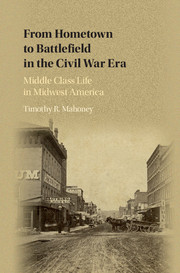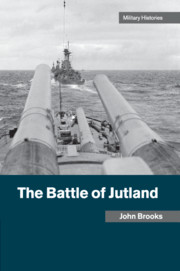Refine search
Actions for selected content:
15418 results in Military history

From Hometown to Battlefield in the Civil War Era
- Middle Class Life in Midwest America
-
- Published online:
- 05 May 2016
- Print publication:
- 17 May 2016

The Battle of Jutland
-
- Published online:
- 05 May 2016
- Print publication:
- 09 May 2016
Index
-
- Book:
- <I>The Book of Horsemanship</I> by Duarte I of Portugal
- Published by:
- Boydell & Brewer
- Published online:
- 05 July 2016
- Print publication:
- 21 April 2016, pp 171-172
-
- Chapter
- Export citation
Note on the Translation
-
- Book:
- <I>The Book of Horsemanship</I> by Duarte I of Portugal
- Published by:
- Boydell & Brewer
- Published online:
- 05 July 2016
- Print publication:
- 21 April 2016, pp 45-46
-
- Chapter
- Export citation
Contents
-
- Book:
- <I>The Book of Horsemanship</I> by Duarte I of Portugal
- Published by:
- Boydell & Brewer
- Published online:
- 05 July 2016
- Print publication:
- 21 April 2016, pp v-v
-
- Chapter
- Export citation
The Book of Horsemanship by Duarte I of Portugal
-
- Book:
- <I>The Book of Horsemanship</I> by Duarte I of Portugal
- Published by:
- Boydell & Brewer
- Published online:
- 05 July 2016
- Print publication:
- 21 April 2016, pp 47-154
-
- Chapter
- Export citation
Frontmatter
-
- Book:
- <I>The Book of Horsemanship</I> by Duarte I of Portugal
- Published by:
- Boydell & Brewer
- Published online:
- 05 July 2016
- Print publication:
- 21 April 2016, pp i-iv
-
- Chapter
- Export citation
Bibliography
-
- Book:
- <I>The Book of Horsemanship</I> by Duarte I of Portugal
- Published by:
- Boydell & Brewer
- Published online:
- 05 July 2016
- Print publication:
- 21 April 2016, pp 155-170
-
- Chapter
- Export citation
List of Plates
-
- Book:
- <I>The Book of Horsemanship</I> by Duarte I of Portugal
- Published by:
- Boydell & Brewer
- Published online:
- 05 July 2016
- Print publication:
- 21 April 2016, pp vi-vi
-
- Chapter
- Export citation
Acknowledgements
-
- Book:
- <I>The Book of Horsemanship</I> by Duarte I of Portugal
- Published by:
- Boydell & Brewer
- Published online:
- 05 July 2016
- Print publication:
- 21 April 2016, pp vii-viii
-
- Chapter
- Export citation
Introduction
-
- Book:
- <I>The Book of Horsemanship</I> by Duarte I of Portugal
- Published by:
- Boydell & Brewer
- Published online:
- 05 July 2016
- Print publication:
- 21 April 2016, pp 1-44
-
- Chapter
- Export citation
5 - Canada, Military Scottishness and the First World War
- from PART 2
-
-
- Book:
- A Global Force
- Published by:
- Edinburgh University Press
- Published online:
- 12 September 2017
- Print publication:
- 15 April 2016, pp 93-127
-
- Chapter
- Export citation
3 - The Scottish Soldier and Scotland, 1914–1918
- from PART 1
-
-
- Book:
- A Global Force
- Published by:
- Edinburgh University Press
- Published online:
- 12 September 2017
- Print publication:
- 15 April 2016, pp 53-70
-
- Chapter
- Export citation
Acknowledgements
-
- Book:
- A Global Force
- Published by:
- Edinburgh University Press
- Published online:
- 12 September 2017
- Print publication:
- 15 April 2016, pp ix-x
-
- Chapter
- Export citation
PART 2
-
- Book:
- A Global Force
- Published by:
- Edinburgh University Press
- Published online:
- 12 September 2017
- Print publication:
- 15 April 2016, pp 71-72
-
- Chapter
- Export citation
4 - Performing Scottishness in England: Forming and Dressing the London Scottish Volunteer Rifles
- from PART 2
-
-
- Book:
- A Global Force
- Published by:
- Edinburgh University Press
- Published online:
- 12 September 2017
- Print publication:
- 15 April 2016, pp 73-92
-
- Chapter
- Export citation
7 - South Africa and Scotland in the First World War
- from PART 2
-
-
- Book:
- A Global Force
- Published by:
- Edinburgh University Press
- Published online:
- 12 September 2017
- Print publication:
- 15 April 2016, pp 150-167
-
- Chapter
- Export citation
Introduction A Global Force: War, Identities and Scotland's Diaspora
-
-
- Book:
- A Global Force
- Published by:
- Edinburgh University Press
- Published online:
- 12 September 2017
- Print publication:
- 15 April 2016, pp 1-10
-
- Chapter
- Export citation
Foreword
-
-
- Book:
- A Global Force
- Published by:
- Edinburgh University Press
- Published online:
- 12 September 2017
- Print publication:
- 15 April 2016, pp xi-xii
-
- Chapter
- Export citation
Frontmatter
-
- Book:
- A Global Force
- Published by:
- Edinburgh University Press
- Published online:
- 12 September 2017
- Print publication:
- 15 April 2016, pp i-iv
-
- Chapter
- Export citation
